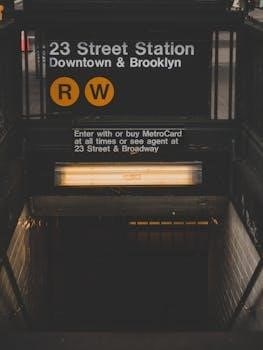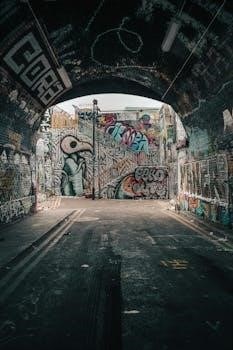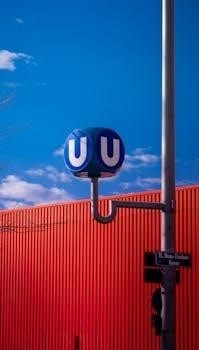Montreal Underground City (RÉSO)⁚ A Comprehensive Guide
Montreal’s Underground City, officially known as RÉSO, offers a unique urban experience. This comprehensive guide explores the RÉSO’s intricate network. It links metro stations, shopping centers, and various attractions. Discover how to navigate this subterranean world using readily available PDF maps. Explore the benefits and key features within RÉSO.
Montreal’s Underground City, also known as RÉSO (from the French word “réseau,” meaning network), presents a fascinating subterranean dimension to the vibrant metropolis. This elaborate network of interconnected tunnels and passageways offers a climate-controlled environment, shielding pedestrians from the harsh weather conditions that Montreal often experiences, especially during the frigid winter months and sweltering summer days.
RÉSO is more than just a means of escaping the elements; it’s a thriving ecosystem comprising shopping malls, office complexes, hotels, residential buildings, cultural venues, and even universities. Imagine strolling through a bustling marketplace, attending a conference, or commuting to work, all without stepping foot outside. This is the reality for hundreds of thousands of people who utilize RÉSO daily.
For visitors, RÉSO provides an unparalleled opportunity to explore Montreal’s downtown core in comfort and convenience. The network connects numerous key landmarks and attractions, making it easy to navigate the city’s diverse offerings. To fully appreciate the scope and complexity of RÉSO, a detailed map is essential. Fortunately, several resources provide downloadable PDF maps, allowing you to plan your underground adventures and discover hidden gems within this unique urban landscape.
What is RÉSO? Defining the Underground Network
RÉSO, often referred to as Montreal’s Underground City, is a sprawling network of interconnected tunnels and passageways beneath the city’s downtown core. It’s more than just a simple tunnel system; it’s a fully functional subterranean metropolis that integrates seamlessly with the surface-level city. The name RÉSO is derived from the French word “réseau,” meaning network, which aptly describes its intricate and interconnected nature.
This underground network connects various essential components of Montreal’s urban landscape, including metro stations, shopping malls, office towers, hotels, residential complexes, universities, and cultural venues. It provides a climate-controlled environment, offering refuge from the harsh weather conditions that characterize Montreal’s seasons.
RÉSO allows pedestrians to navigate the downtown area with ease and comfort, regardless of the weather outside. It facilitates daily commutes, shopping trips, and access to various services and attractions. For many, it’s an integral part of their daily lives, providing a convenient and efficient way to move around the city. To understand its vastness and complexity, a detailed map is crucial. PDF maps of RÉSO are readily available, offering a comprehensive overview of the network’s layout, access points, and key destinations, empowering users to explore and navigate this unique urban space effectively.
History and Development⁚ Origins and Evolution of RÉSO
The origins of Montreal’s RÉSO, or Underground City, can be traced back to the 1960s, driven by the vision to create a climate-controlled environment that would shield citizens from the city’s harsh winters. The initial concept was to connect Place Ville Marie, a prominent office tower, with the surrounding areas, allowing people to move between buildings without braving the elements.
Over the decades, RÉSO gradually expanded, with new sections and connections added to the network. This expansion was often linked to the development of new metro stations and commercial complexes, creating a symbiotic relationship between the underground network and the city’s infrastructure. The construction of each new segment contributed to the growing complexity and reach of RÉSO.
The evolution of RÉSO has been shaped by various factors, including urban planning initiatives, economic development, and the desire to enhance the quality of life for Montrealers. Today, it stands as a testament to innovative urban design and the ability to adapt to changing needs. As RÉSO continued to grow, maps became essential tools for navigation. PDF maps have become invaluable for both residents and tourists, providing a visual guide to its sprawling layout, and ensuring accessibility for all who wish to explore this unique underground realm.
Accessibility⁚ Points of Entry and Access from Key Locations
Montreal’s RÉSO, or Underground City, offers numerous access points, making it easily accessible from key locations throughout the downtown core. These entry points are strategically positioned to connect with metro stations, office buildings, hotels, shopping centers, and other major landmarks, allowing for seamless transitions between the surface and subterranean levels.
Key access points include entrances within major metro stations such as Peel, McGill, Bonaventure, and Place-des-Arts. These stations serve as vital hubs, providing direct access to the network. Moreover, many hotels, including Le Westin near Old Montreal, offer direct access to RÉSO, providing convenient options for visitors seeking to explore the city regardless of weather conditions.
Navigating RÉSO’s access points is facilitated by clear signage and maps available throughout the network and in metro stations. PDF maps can be downloaded for offline use, ensuring visitors can easily locate entry points from various starting locations; Whether arriving by metro, staying in a downtown hotel, or visiting a specific attraction, access to the RÉSO is designed to be convenient and user-friendly. The integration of these entry points makes the Underground City a vital part of Montreal’s urban infrastructure.
Navigating RÉSO⁚ Using Maps and Signage

Successfully navigating Montreal’s extensive Underground City, or RÉSO, relies on understanding its map system and utilizing the available signage. The RÉSO network, spanning over 33 kilometers, can initially seem complex, but with the right tools, it becomes quite manageable. Maps of the Underground City are available in various formats to aid navigation, including free maps at all metro stations and downloadable PDF versions for offline access.
The signage within RÉSO is designed to guide pedestrians efficiently. Look for the RÉSO logo, a stylized ‘O’ representing the Montreal Metro, which marks entrances and pathways throughout the network. These signs often include directional arrows and names of key destinations, such as metro stations, shopping malls, and prominent buildings. The maps provide a comprehensive overview of the network, highlighting connecting points, metro lines, and major attractions.
For those unfamiliar with RÉSO, starting with a downloaded PDF map can be particularly helpful. These maps offer a detailed layout of the underground pathways, allowing users to plan their routes in advance. By combining map references with attentive observation of the signage, navigating RÉSO becomes an intuitive experience, ensuring visitors and locals alike can efficiently traverse this underground labyrinth.
RÉSO Map Availability⁚ Where to Find and Download PDF Maps
Locating and accessing maps of Montreal’s RÉSO, the Underground City, is crucial for efficient navigation. Several resources offer both physical and digital maps, ensuring everyone can explore this subterranean network with ease. Free printed maps are readily available at all Montreal Metro stations. These maps provide a general overview of the RÉSO, highlighting key connections and major points of interest.
For those who prefer digital convenience, downloadable PDF maps are available from various online sources. The official Montreal tourism website often provides a current version of the RÉSO map in PDF format. Additionally, websites and apps specializing in Montreal public transportation, such as Moovit, may offer downloadable maps for offline use. These digital maps are particularly useful for planning routes in advance and navigating without relying on an internet connection.
Furthermore, many hotels and information kiosks throughout downtown Montreal also distribute RÉSO maps. By checking these locations, visitors can easily obtain a physical copy. Whether opting for a printed map from a metro station or a downloaded PDF for your mobile device, accessing a RÉSO map is simple, ensuring you can confidently explore Montreal’s Underground City.
Key Features and Attractions within RÉSO
Montreal’s RÉSO, or Underground City, is more than just a network of tunnels; it’s a vibrant hub brimming with key features and attractions. Spanning over 33 kilometers, the RÉSO connects a diverse array of locations, including shopping malls, hotels, office towers, and entertainment venues. This extensive network ensures that visitors and residents alike can access essential services and leisure activities, regardless of the weather conditions above ground.
Among the major attractions within the RÉSO are renowned shopping centers like the Montreal Eaton Centre and Place Ville Marie. These retail hubs offer a wide selection of stores, from high-end boutiques to everyday essentials. The RÉSO also provides access to cultural landmarks such as museums and performance spaces, allowing individuals to seamlessly transition between cultural experiences and practical amenities.
Furthermore, the Underground City features numerous dining options, ranging from quick-service eateries to upscale restaurants, catering to diverse tastes and preferences. Public art installations are strategically placed throughout the RÉSO, adding an artistic touch to the utilitarian passageways. By exploring the RÉSO, one can discover a multitude of attractions, making it a compelling destination in its own right.
Connecting Points⁚ Metro Stations Linked to RÉSO
The Montreal Metro system plays a crucial role in the accessibility and functionality of RÉSO, the Underground City. Several key metro stations serve as primary connecting points, seamlessly integrating the underground network with the city’s public transportation system. These stations act as gateways, allowing commuters and visitors to easily transition between the Metro and the various attractions and amenities within RÉSO. Prominent stations like Bonaventure, Peel, McGill, and Place-des-Arts are directly linked to the Underground City, providing convenient access to numerous destinations.
Bonaventure station, for instance, offers a direct connection to the Central Station, connecting the RÉSO to the train network. Peel and McGill stations are situated in the heart of downtown, providing access to major shopping centers, office buildings, and hotels within the Underground City. Place-des-Arts station links the RÉSO to Montreal’s cultural district, enabling easy access to theaters, museums, and performance venues.
These metro connections are strategically located to maximize convenience and accessibility, making it easy for individuals to navigate the Underground City and explore its various offerings. The integration of the Metro system with RÉSO highlights the city’s commitment to providing an efficient and user-friendly transportation network.

Impact on Daily Life⁚ How RÉSO Serves the Community

RÉSO, Montreal’s Underground City, significantly impacts the daily lives of residents and visitors alike, becoming an integral part of the city’s infrastructure. It provides a climate-controlled environment, offering refuge from Montreal’s harsh weather conditions, particularly during the winter months. This allows individuals to commute, shop, and access various services without being exposed to the elements.
The Underground City also enhances connectivity within downtown Montreal, linking metro stations, office buildings, shopping centers, and cultural venues. This interconnectedness streamlines transportation and reduces travel time, making it easier for people to navigate the city. RÉSO serves as a pedestrian network, promoting walkability and reducing reliance on vehicular transportation within the downtown core.
Moreover, RÉSO provides access to a wide range of amenities and services, including retail stores, restaurants, and entertainment options. This creates a vibrant and dynamic environment that caters to the needs of the community. The Underground City also supports local businesses by providing them with a unique and accessible location to operate.
Overall, RÉSO plays a vital role in enhancing the quality of life for Montrealers by providing a convenient, climate-controlled, and interconnected urban space.
Benefits of Using RÉSO⁚ Weather Protection and Convenience
RÉSO, Montreal’s renowned Underground City, offers a multitude of benefits, primarily centered around weather protection and unparalleled convenience. In a city known for its extreme seasonal variations, RÉSO provides a climate-controlled environment, shielding pedestrians from the bitter cold of winter and the sweltering heat of summer. This feature allows for comfortable year-round access to various destinations within the downtown core.
The interconnected network of tunnels and passageways eliminates the need to brave the elements, making it ideal for commuters, shoppers, and tourists alike. Imagine navigating the city without having to worry about snowstorms, rain, or excessive heat. RÉSO makes this a reality, enhancing the overall urban experience.
Beyond weather protection, RÉSO offers exceptional convenience. It seamlessly connects numerous metro stations, office towers, shopping malls, hotels, and cultural attractions, streamlining transportation and reducing travel time. This interconnectedness simplifies daily commutes and errands, allowing individuals to efficiently access various services and amenities.
Furthermore, RÉSO provides a safe and well-maintained pedestrian environment, offering an alternative to crowded streets and vehicular traffic. This promotes walkability and reduces reliance on cars, contributing to a more sustainable and pedestrian-friendly city.
Art and Culture in RÉSO⁚ Public Art Installations
Montreal’s RÉSO, the Underground City, transcends its functional role as a pedestrian network and emerges as a vibrant hub for art and culture, showcasing a diverse collection of public art installations. These artistic expressions transform the subterranean environment into an engaging and thought-provoking space, enriching the experience of those who traverse its corridors.
The RÉSO’s commitment to public art is evident in the presence of numerous sculptures, murals, mosaics, and other artistic creations that adorn its walls and passageways. These installations, often commissioned by the city or private organizations, represent a wide range of styles and themes, reflecting Montreal’s rich cultural heritage and contemporary artistic movements.
The presence of art within RÉSO not only enhances its aesthetic appeal but also fosters a sense of community and civic pride. The installations serve as landmarks and meeting points, encouraging interaction and creating a unique sense of place within the underground network.
Furthermore, the integration of art into RÉSO democratizes access to culture, making it readily available to a broad audience. Commuters, shoppers, and tourists alike can encounter and appreciate art as they navigate the city, blurring the lines between public space and art gallery.
The Art Souterrain festival further amplifies RÉSO’s artistic presence, showcasing temporary exhibitions and performances that transform the underground network into a dynamic cultural venue.
Shopping and Dining⁚ Retail and Culinary Experiences

Montreal’s RÉSO, more than just a subterranean passageway, is a bustling hub of retail and culinary delights. It provides diverse shopping and dining experiences. The underground network features a variety of shops, from boutiques to well-known retail stores. Here, you can find clothing, electronics, books, and souvenirs.
The RÉSO’s dining scene is just as diverse, with options for every palate. From quick bites at fast-food chains to sit-down meals at restaurants, there’s something for everyone. You’ll discover cafes, bistros, and international cuisine.
One of the key benefits of shopping and dining in the RÉSO is weather protection. No matter the weather, you can comfortably explore the shops and restaurants. The climate-controlled environment makes it an appealing option year-round.
The interconnectedness of the RÉSO means you can easily access various retail and dining locations. The network links metro stations, office buildings, and shopping malls. This creates a seamless experience.
Whether you’re a local seeking a convenient lunch spot or a tourist looking for unique souvenirs, RÉSO’s retail and culinary landscape offers a compelling destination. It’s a vibrant part of Montreal’s urban fabric, blending commerce with community.
Practical Information⁚ Hours of Operation and Accessibility
Planning a trip to Montreal’s RÉSO requires knowing the practical details. This includes hours of operation and accessibility information. While some sections align with Metro operating hours (5⁚30 AM to 1⁚00 AM), many areas follow business hours. Individual shops and restaurants within the RÉSO set their own schedules. It’s best to verify specific store or restaurant hours before visiting.
Accessibility is a key consideration. The RÉSO aims to be inclusive, but accessibility varies across different sections. Many areas are wheelchair-accessible, offering ramps and elevators. However, older sections may have limited accessibility features. Check for accessible entrances and routes when planning your visit.
Maps of the RÉSO are available at Metro stations and online. These maps can help you navigate the network and identify accessible routes. The RÉSO also connects directly to several Metro stations. This allows for convenient access from various points in the city.
Understanding these practical details can enhance your experience. Whether you’re commuting, shopping, or exploring, knowing the hours and accessibility options ensures a smooth and enjoyable visit. Always check for updates.
